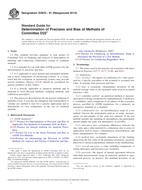We need your consent to use the individual data so that you can see information about your interests, among other things. Click "OK" to give your consent.
ASTM D3670-91(2014)
Standard Guide for Determination of Precision and Bias of Methods of Committee D22
STANDARD published on 1.4.2014
The information about the standard:
Designation standards: ASTM D3670-91(2014)
Note: WITHDRAWN
Publication date standards: 1.4.2014
SKU: NS-24409
The number of pages: 5
Approximate weight : 15 g (0.03 lbs)
Country: American technical standard
Category: Technical standards ASTM
The category - similar standards:
Annotation of standard text ASTM D3670-91(2014) :
Keywords:
accuracy, bias, candidate method, collaborative test, laboratory bias, method bias, over-all precision, relative overall uncertainty, ruggedness test, single-operator precision, ICS Number Code 13.100 (Occupational safety. Industrial hygiene)
Additional information
| Significance and Use | ||||||||||||
|
5.1 The objective of this standard is to provide guidelines to Committee D22 for the evaluation of the precision and bias, or both, of ASTM standard methods and practices at the time of their development. Such an evaluation is necessary to assure that a cross section of interested laboratories could perform the test and achieve satisfactory results, using the method as written. It also provides guidance to the user as to what levels of precision and accuracy may be expected in such usage. 5.2 The write-up of the method describes the media for which the test method is believed to be appropriate. The collaborative test corroborates the write-up within the limitations of the test design. A collaborative test can only use representative media so that universal applicability cannot be implied from the results. 5.3 The fundamental assumption of the collaborative test is that the media tested, the concentrations used, and the participating laboratories are representative and provide a fair evaluation of the scope and applicability of the test method as written. |
||||||||||||
| 1. Scope | ||||||||||||
|
1.1 This standard provides guidance to task groups of Committee D22 on Sampling and Analysis of Atmospheres in planning and conducting collaborative testing of candidate methods. 1.2 It is intended for use with other ASTM practices for the determination of precision and bias. 1.3 It is applicable to most manual and automated methods and to most components of monitoring systems. It is recognized that the evaluation of monitoring systems may provide special problems. Practice D3249 should be considered for general guidance in this respect. 1.4 It is directly applicable to chemical methods and in principle to most physical methods, sampling methods, and calibration procedures. 1.5 The processes described are for the general validation of methods of test. A user has the obligation and responsibility to validate any method it uses for a specific application and to demonstrate its own competence in the use of validated methods. |
||||||||||||
| 2. Referenced Documents | ||||||||||||
|
We recommend:
Technical standards updating
Do you want to make sure you use only the valid technical standards?
We can offer you a solution which will provide you a monthly overview concerning the updating of standards which you use.
Would you like to know more? Look at this page.




 Cookies
Cookies
